During the planning phase of your house construction project, you must consider numerous details – room layout, doorways, furniture layouts, and so on. While most people have a pretty good idea of what they want when it comes to the rooms themselves, the subject of window space is often overlooked.
In the end, you can’t get too creative with windows, right? You just need enough to let natural light in, and that’s about it. However, there are some things you should keep in mind when talking to your contractor about how many windows you need.
Bedroom windows will obviously be different from the living room or kitchen windows. At the same time, adding skylights instead of a roof window in the attic might be a better option to benefit from warm light. In the bathroom, you might not need any windows at all or utilise roof space instead.
Here’s a look at some general guidelines to help you determine how many windows you need for each room in your new house.
Table of Contents
Why You Should Maximise Natural Light
Before deciding how many windows you want to install in your home, it’s worth reconsidering your vision of an ideal space and learning more about the benefits of natural light.
Natural sunlight provides a great ambience for any room. Unlike directional light from lamps and overhead fixtures, it can brighten up the space without being too harsh.
Roof windows are especially valuable in this regard, inviting more natural light into the room in an unobtrusive way. Such neutral light dissipates in a room more evenly, filling it with a soft and welcoming glow and preventing stark shadows.
Maximising the amount of natural light in your home will also improve your energy savings. First, it will help reduce your dependence on electric lighting during the daytime hours. Second, it can help heat your home during the colder months; a sufficient amount of sunlight coming in through the windows can increase the indoor temperature by a few degrees.
Last but not least, natural light plays a vital part in your overall health and well-being. Exposure to sunlight – even in small doses – can improve your mood and cognitive function while boosting your immune system. It can also help mitigate the effects of seasonal affective disorder (SAD), a type of depression that often occurs during the shorter, darker days of winter.
How Many Windows Does a Room Need?
The answer to this question depends on multiple factors, including the size and layout of each room as well as its intended purpose. You’ll usually find the more windows you have, the better.
Before you start planning your window installation, consider the following factors.
Room Type
Needless to say, the type of room you’re planning to put the windows in will have a lot to do with how many windows it needs. The size of the room, its purpose, and even how much furniture you plan to put in it will all contribute to your final in it.
For example, if the room in question is quite compact and located on the top floor of your house, installing one flat roof window may provide a sufficient amount of natural light.
As a general rule, bedrooms should have at least two windows to provide natural light. Living rooms can get away with just one large window paired with a set of French doors and still look bright and airy, while kitchens and bathrooms require at least one window to provide adequate ventilation.
Furniture Placement
When planning your house, you should also take into account the amount of furniture you plan to put in each room and where you will place that furniture. You don’t want to obstruct windows with bulky furniture, after all.
Even if you use your ceiling space to add double-glazing roof windows, you should be careful not to cut off the light with hanging shelves and other furniture pieces.
For example, you might have your heart set on a king-sized bed in the main bedroom, but if that means you’ll have to put the bed directly in front of the window, you should reconsider. The same goes for any large pieces of furniture that you will place near the windows.
The Environment
This point is a big one. The area surrounding your home will directly impact how much light it gets.
If you live in an area with many trees that shed their leaves in the fall and winter, your home will probably get more natural light during those months. Conversely, if you live in an area with high-rise buildings or other structures that tend to block the sun, it may simply be impossible to get enough natural light during certain times of the year.
Privacy
Speaking of the environment, you’ll also want to take your neighbours into consideration when deciding how many windows to put in each room. Indeed, you can install blinds and curtains to help ensure privacy, but you probably don’t want to have your windows look out onto your neighbour’s bedroom.
This isn’t to say that you shouldn’t have any windows in those rooms, but you might want to consider placing them higher up on the wall.
Again, your roof space might come in handy. Adding skylights or roof windows to your room is a great option to get more natural light without having to worry about peeping Toms.
Using frosted glass for private areas like bathrooms and bedrooms is also a good alternative.
House Orientation
Another factor to consider is the orientation of the house itself. If your home is positioned so that it faces the south, you’ll receive more sunlight throughout the day than if it is oriented toward the north. So, depending on your needs, you may want to position the windows differently.
If you’re looking to maximise the amount of sunlight in a room in order to take advantage of passive solar heating, you’ll want the windows on that side of the house to be as large as possible. Large windows placed on the north wall will provide you with less direct sunlight, but they’ll still let in a reasonable amount of diffused light.
The Climate
Finally, the climate in your area will have a direct impact on how much light you get and, as such, how many windows you need. Generally speaking, homes in sunny climates tend to sway more toward having windows on the less sunny side of the house, while homes in cloudy or rainy climates aim to tap into whatever sunlight they can get.
It would be best to account for all seasons when planning your windows. The sun’s path changes throughout the year, so a room that gets direct sunlight in the summer might be quite dark during the winter months. Managing this factor will require some in-depth planning on your part, but it’s worth it to ensure that you get the most natural light possible year-round.
Optimal Window Space
Having all the above in mind, you can start planning the optimal window space for each room in your home. As far as the building standards go, a room designed for human occupancy must have at least one-eighth of its floor space in the form of operable windows. It might be challenging to have fewer windows than that, save for the case of a huge multi-use space.
Most people prefer natural sunlight to electric lights, so you might want to install more windows than the exact requirements.
Your west-facing rooms should make the most of the sunlight in the afternoon, with many windows pointing in that direction. For north and east-facing rooms, you may want to invest in skylights; doing so will prevent the rooms from feeling too dark and obscure.
Does Your Room Need a Window?
As mentioned above, certain laws and regulations dictate the minimum number of windows for each room, their size, and so on. In the UK, for instance, at least one window in each room must serve as an emergency exit in case of a fire, with at least 0.33 square metres of an unobstructed opening.
There are no such strict requirements for residential construction in the US, but most building codes specify that every room must have at least one openable window. The rationale behind this is to provide ventilation, as well as a potential emergency exit if necessary.
Of course, some rooms, such as storage closets and laundry rooms, may not need any windows, but those are not considered habitable rooms. In most cases, you’ll find that even the smallest room in your home will benefit from having at least one window. The window size you choose for the said area is an entirely different matter.
What Windows Should I Choose?
Once you’ve decided how many windows your room needs, it’s time to start thinking about the type of windows you want. The most basic distinction is between traditional windows and roof windows.
- Standard windows are the ones we typically think of when picturing a window; they are placed at or near eye level and openable. Common examples of traditional windows include casement, sash, and hung windows.
- Roof windows, as the name suggests, are installed in the roof – in the form of flat roof windows installed on the ceiling, pitched roof windows, which are designed to be installed in sloped ceilings, and skylights, typically installed on a roof extension.
Other products in category: Flat Roof Windows
£495.83 tax excl.
Other products in category: Flat Roof Windows
£845.83 tax excl.
There are also a few other factors to consider when choosing your windows, with size and shape being two of the most important ones. One window opening can accommodate multiple smaller windows or one large window – it all depends on your preferences.
Glazing is another essential factor to consider.
Single-glazed windows are not very effective at insulating your home, both from hot and cold weather. Double-glazed windows are much better, as additional glazing offers improves isolation. You can also get triple-glazed windows for even more insulation, though they tend to be quite a bit more expensive.
Last but not least, you should also consider the window frame material. The most popular options are wood, aluminium, and PVC.
Wood is the most traditional choice – it looks great, but it may be difficult to maintain if you live in an area with high humidity. Aluminium and PVC are both low-maintenance options and are also quite a bit cheaper than wood.

